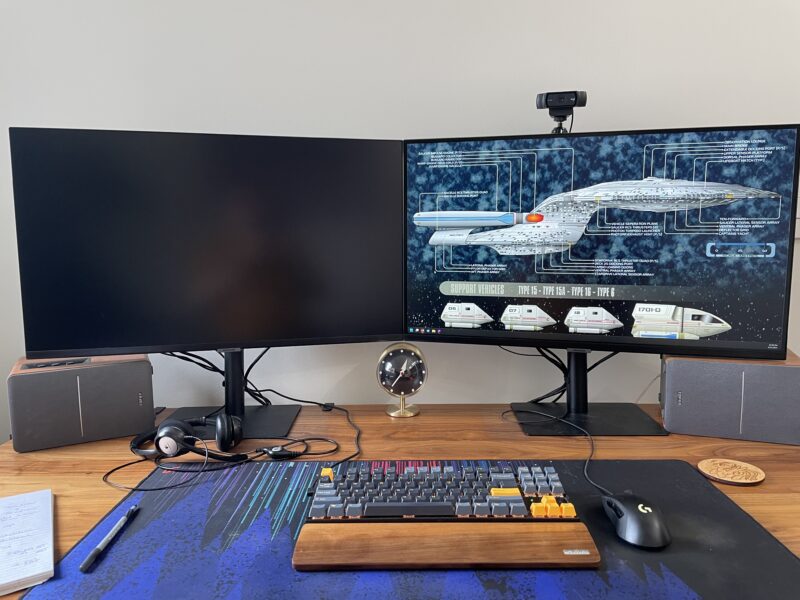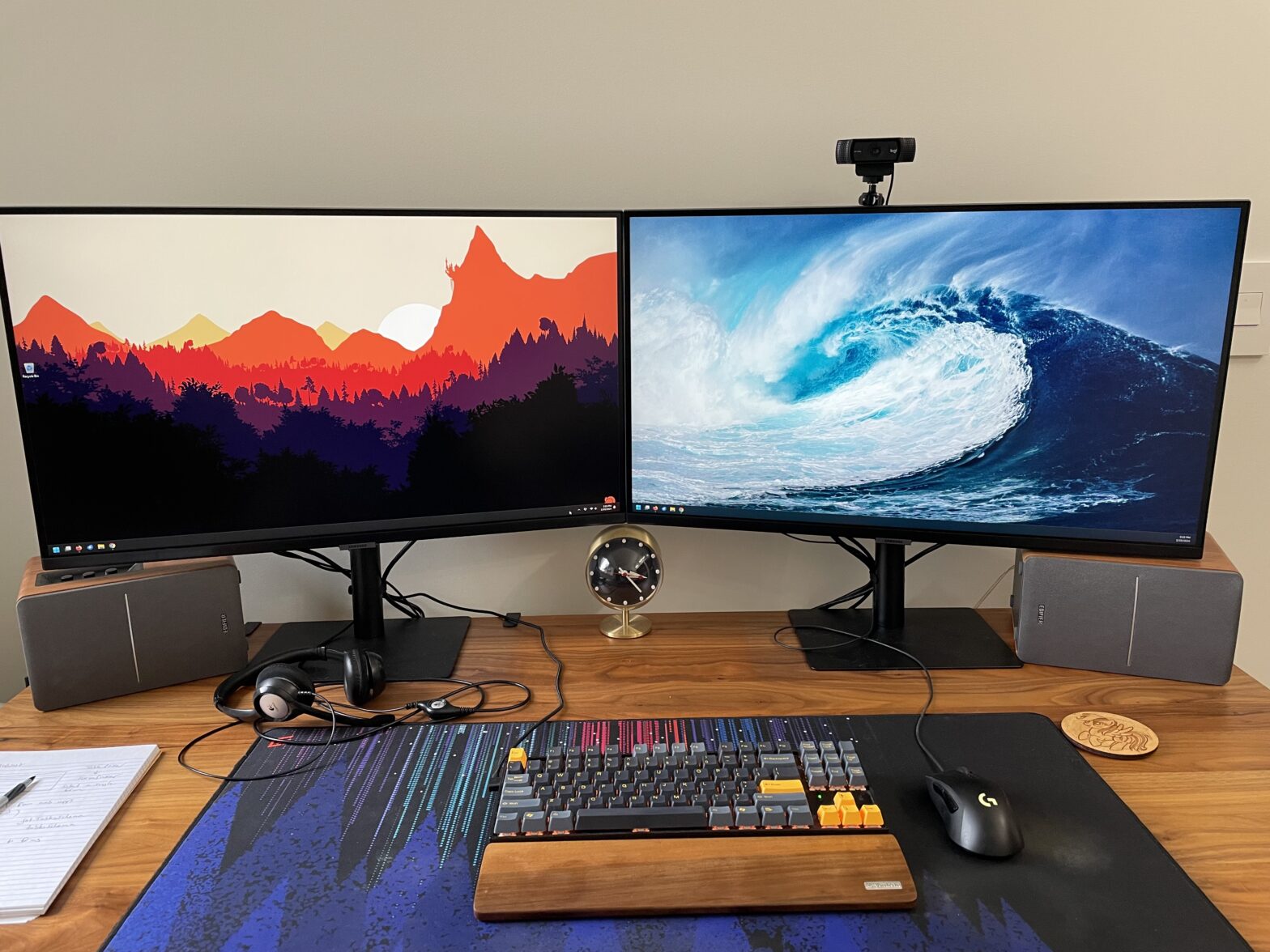Recently I upgraded my monitors from a pair of Dell 24 inch displays to a pair of Samsung 32 inch displays 1– but ever since then, there’s been an odd little quirk that, in the grand scheme of things, isn’t a big deal, but it annoys me to no end and I can’t for the life of me figure out why it happens.
What happens is this: I have my displays set in Windows to turn off after 10 minutes of inactivity. But when I come back and wake the computer up, one of the displays comes back on, while the other one just… doesn’t. (Sometimes, just to make things more difficult to troubleshoot, it does come back on.)

Due to the ports on my graphics card2 I have to use both DisplayPort and HDMI if I want to have dual monitors (it has 1 port of each), and it is always the DisplayPort monitor that has the trouble waking up.
When this first happened I checked all the usual suspects: cables, connections, monitor settings, drivers, firmware updates, power settings, etc, but I couldn’t find anything wrong. The problem was specific to DisplayPort: whichever monitor was connected via DisplayPort would not wake up after being put to sleep. (I of course tried switching the monitors, but it didn’t make any difference – whichever one was using DisplayPort was always the one that wouldn’t wake up.)
Confusingly, this problem only applies to my desktop computer – when the monitors are connected to my work laptop (via a dock/KVM that connects to the laptop over USB-C) they have no problem waking up.
Strangely, my computer still recognizes that the monitor is there and connected – it shows as 2 screens under display settings – but the monitor display itself just won’t turn on. This is all the more confusing when you remember that DisplayPort is an active connection protocol – if you unplug a DisplayPort monitor, the computer recognizes it, just as if you’d unplugged a USB device. So if the monitor was really going to sleep, the computer should see it as being disconnected… but it doesn’t; it is still “awake” enough to be recognized as connected, but not “awake” enough to actually display anything.
The monitor will wake up if you use it’s on-screen menu to change the input to something else and then back again. It will also wake up if you force a Windows graphics reset using CTRL+SHIFT+WIN+B.
My monitors are hooked up via a combination KVM/dock so I can switch between my PC and my work laptop (see: The Switching Saga). The laptop is connected via just a single USB-C connection, while my PC is connected via a standard USB-A cable (for the built-in hub in the monitor) and separate HDMI and DisplayPort connections for the video for each monitor. I don’t know that the KVM makes any difference – it should be just effectively just a pass-through switch – but it is possible that it is messing with the signals in some way.
That said though, for the life of me I can’t figure out what could be the problem given that sometimes it just doesn’t happen! Every once in a while I’ll jiggle the mouse to wake up the display and both screens will come to life, just like they should… but most of the time, only the HDMI display wakes up.
As an interesting aside, I’ve noticed that when the display does come back to life as it’s supposed to, my computer makes the sound associated with connecting a device (i.e., plugging in a USB device). I’m not sure if this is the monitor’s USB hub reconnecting, or the DisplayPort connection reconnecting, as they both would make the same sound.
I had almost given up on figuring this problem… but in the course of writing this post I decided to try troubleshooting the issue again. There were no new firmware updates for the monitor, so I went through the on-screen menu one last time to see if there was perhaps a setting I hadn’t tried. On a whim, I changed the setting for “DP Out” from “DisplayPort SST” to “DisplayPort MST” and… incredibly, amazingly, and confusingly, the problem seemed to go away!
DisplayPort MST (standing for “Multi-Stream Transport”) is a feature of DisplayPort 1.2 that allows you to daisy-chain a second monitor by plugging it into the first monitor, rather than back into the PC. I had actually tried using it with my prior set of Dell monitors, but found it was a bit unreliable – the second downstream monitor would sometimes not work – and so I settled back on just connecting each monitor independently, and this is the setup I kept when I got the new monitors.
So I wasn’t sure why this would’ve made a difference – yet it certainly seemed to. I let my monitors go to sleep multiple times, and each time they both woke up just as they should when I wiggled the mouse or pressed a key on the keyboard.
However, as I was wrapping up this post – all ready to say “if you’re having this problem, try this…” – the problem happened again.
You can imagine my frustration – I thought I’d finally fixed the issue, and it was working for a full 24 hours, until suddenly it wasn’t (for no apparent reason).
To add insult to injury, with the monitor set to DisplayPort MST, now my laptop wasn’t working – when I switched to it, the DisplayPort monitor simply would not display anything. Even tricks like CTRL+SHIFT+WIN+B or turning the monitor on & off or unplugging the whole thing from the laptop wouldn’t do anything – it simply refused to activate.
So I was back to square one. But it got me thinking… what about that DisplayPort MST thing? Would it work reliably with these monitors, and would my laptop work right if I actually had the 2 connected using MST? Or would my KVM cause issues, or perhaps my laptop just flat out doesn’t support DisplayPort MST over USB-C (which itself is using DisplayPort “Alt Mode”)?
Well, it turns out that while my desktop is perfectly happy to drive both monitors over a single DisplayPort cable using MST, may laptop is… not. Whatever display modes it supports over USB-C, it doesn’t support MST – which is especially weird, when you think about it, because it is still driving 2 displays (via the KVM/hub), it just is doing it as DisplayPort + HDMI instead of DisplayPort + DisplayPort.
So, despite all of this, I ended up right back where I started – when using my PC, sometimes both of my screens wake up from sleep, and sometimes they don’t (but my laptop has no issues waking them both up).
Maybe someday there’ll be a driver update or a firmware update that fixes this issue – I’ll keep checking every so often – or maybe I’ll just be stuck with it until I’m forced to get new displays. But if anyone out there has any ideas or suggestions, or if you’ve run into this problem yourself, I’d love to hear about it!

A while ago I wrote about my attempt to find a KVM-style switch that could handle switching all my USB devices and my 2 monitors…